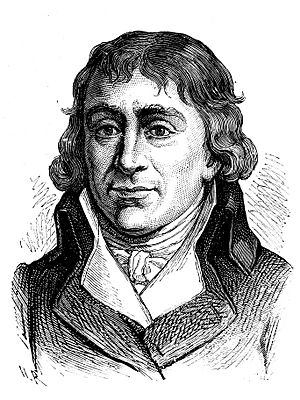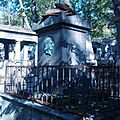Pierre Claude François Daunou facts for kids
Quick facts for kids
Pierre Claude François Daunou
|
|
|---|---|
 |
|
| Born |
Pierre Claude François Daunou
18 August 1761 |
| Died | 20 June 1840 (aged 78) |
| Known for | French statesman and historian |
Pierre Claude François Daunou (born August 18, 1761 – died June 20, 1840) was an important French leader. He lived during the exciting and sometimes difficult times of the French Revolution and the Empire. He was also a talented writer and historian. For many years, he was the nation's main archivist, which means he was in charge of keeping important historical documents. He wrote many books and gave many lectures about history and ethics.
Contents
Early Life and Studies
Pierre Daunou was born in a town called Boulogne-sur-Mer in France. When he was young, he studied at a school run by a religious group called the Oratorians. He liked it so much that he joined the group himself in 1777.
From 1780 to 1787, he taught at different schools. Then, he became a priest. Even before this, he had already written essays and poems. These writings made him well-known in the world of literature.
A Time of Revolution
When the French Revolution began, Pierre Daunou supported a new law about the church called the Civil Constitution of the Clergy. He was offered a high position in the Catholic Church, but he refused to change his mind about supporting the new law.
Later, he was chosen to be a part of the National Convention. This was a big meeting where leaders made important decisions for France. He joined a group of moderate politicians called the Girondists. He strongly disagreed with the decision to execute King Louis XVI.
Pierre Daunou did not get deeply involved in the fights between the Girondists and a more radical group called The Mountain. However, when the Girondists lost power in 1793, he was put in prison. He stayed there for almost a year.
Helping Shape the Government
In December 1794, Pierre Daunou returned to the National Convention. He was the main person who wrote the Constitution of the Year III. This new set of rules created a government called the Directory in November 1795.
He also helped create the plans for the Institut de France. This important institution is still a major center for learning and arts in France today. He also played a key role in stopping a rebellion by people who wanted the old royal family back. This event was known as the 13 Vendémiaire.
Pierre Daunou was chosen by many parts of France to be a member of the Council of Five Hundred. He even became its first president. He was not old enough to be a director himself, because he had set the age limit for that job at 40, and he was only 34. When the government changed hands, Daunou went back to writing for a short time. In 1798, he was sent to Rome to help set up the Roman Republic there.
Under Napoleon and Beyond
In 1799, Pierre Daunou returned to politics. He helped write the Constitution of the Year VIII, which created the Consulate. Under this new government, Napoleon Bonaparte became the First Consul.
Daunou had mixed feelings about Napoleon. However, he supported Napoleon against Pope Pius VII and the Papal States. He even wrote a scholarly book in 1809 called On the Temporal Power of the Papacy. In this book, he used historical facts to argue against the Pope's political power.
Even so, he didn't take a big part in Napoleon's government because he felt resentful. He spent more and more time on literature. When the old royal family returned to power in 1814, he lost his job as the "archivist of the Empire."
In 1819, he became a professor of history and ethics at the Collège de France. His classes were very popular during that time. When a new king came to power in 1830, Daunou got his old job back, but it was now called "archivist of the Kingdom." In 1839, he was given the title of a peer, which was a high honor.
Legacy

Pierre Daunou is remembered as an important figure in French history. He helped shape the government during a very turbulent time. He also contributed greatly to history and literature through his writings and teachings.
Images for kids
See also
 In Spanish: Pierre Daunou para niños
In Spanish: Pierre Daunou para niños
- Society of the Friends of Truth


